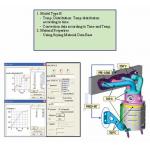Latest News
September 1, 2005
By L. James Ashley
CAE tools capable of multiphysics can be difficult for design engineers to learn and use because each discipline adds a layer of complexity to the user interface and model. The alternatives—waiting in a queue for an analyst, not running virtual tests, or running physical tests—are fraught with issues such as over- or under-engineering, higher development costs, increased cycle time, and substantial warranty costs. After a five-point evaluation of FEA (finite element analysis) design analysis software that offered multiphysics capabilities, the research group of Sejong Industrial Company, Ltd. of South Korea, selected PlassoTech’s 3G.author for its design engineers.“We wanted a simulation software meeting all of our requirements, yet substantially increasing the speed of FEA simulation over our current CAE tools,” says Jung, Sejong’s R&D manager. “We required a CAE tool that would enable design engineers to run their own simulations for design of mufflers and exhaust system functionality.”
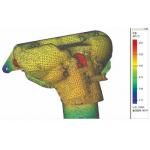 |
| Figure 1: Mesh view with temperature distribution plot (Model Type A). |
Sejong Industrial, a global supplier of exhaust system components like manifolds, mufflers, catalytic converters, resonators, and fittings, has tasked its research group with ensuring the use of best-in-class product development tools and processes that support product development. Specifically, the objective is to ensure tools and processes facilitate new products with better performance characteristics, as well as reduce cycle time and costs. Providing engineers with CAE tools that enable thermal stress analysis, as well as steady state and transient thermal analysis was considered a priority.
According to Sejong’s research group managers, Jung and Sang Ho Kim, finding suitable design engineer-friendly multiphysics CAE tools required an evaluation based on five criteria (ease of use and and product accuracy were inherent in the criteria). The five evaluation criteria included:
1. MCAD connectivity, allowing import of exhaust manifold assembly models from Pro/Engineer to the simulation environment;
2. Robust mesh generation capabilities for tolerances specified in Pro/Engineer data;
3. Automatic detection and definition of contact surfaces in the assembly model;
4. Multiphysics FEA simulation of assembly models for thermal stress, steady state, and transient thermal analysis;
5. A material data library.
Speed & Accuracy
When management says do it faster with more accuracy and less cost, it’s not uncommon to hear muffled groaning. However, such design analysis software as 3G.author is designed to provide speed and accuracy at a low cost. In part, this can be attributed to a solver based on the hp-adaptive method, which is a rare combination of h and p methods in which the p-adaptive method is used within each h refinement step.
The h-adaptive method refines the model by increasing the number of elements and reducing their size. The p-adaptive method enriches the model by increasing the polynomial degree of elements. By automatically manipulating both h and p, convergence to a solution with a very low numerical error continues at an exponential rate, producing a highly efficient method to reach convergence and control the FEA approximation errors.
“The implementation of very efficient FEA solvers based on the hp-adaptive method in 3G.author enables accurate results to be obtained in the most efficient manner,” said Sang Ho Kim. “We get a very versatile definition of convergence criteria for both global and local parameters and advanced features with respect to accuracy, efficiency, and robustness.”
Accuracy can be controlled and tailored for global or local result parameters, including stresses, displacement, and temperature, among others. The localized results can include or exclude any geometric entity, such as faces, edges, and vertices.
MCAD Interface
Integration and associativity with MCAD application software is necessary for any engineering organization. 3G.author seamlessly imports MCAD assemblies from such tools as Pro/Engineer through a simple and efficient method that captures and represents all of the native feature and dimension data of the native MCAD file.
For example, file import is as simple as locating the assembly file and creating a project name. Appropriate folders, subfolders, and files are then created for managing multiple simulations with the same core geometry. Additionally, intelligence built into the importation process maintains the ability to parameterize geometric dimensions and establish the groundwork for optimization.
If the MCAD geometry has changed, 3G.author can clone the model, while maintaining all material property assignments and simulation setups (also known as function studies). Sejong used 3G.author for FEA analysis of two models of manifold assemblies of an exhaust system created in Pro/Engineer, here called Model A and Model B. 3G.author captured the assembly geometry, as well as the native data, such as features and dimensions of the 3D Pro/Engineer models.
Robust Meshing
Meshing with 3G.author is well integrated, and the default is set so a user does not need to perform meshing as a separate step (see Figure 1, above). Materials are assigned, boundary conditions are placed, and the virtual test is run. Transparent to the user, a high-order tetrahedral mesh is created automatically with default settings, which works well for the vast majority of problems. Should the geometry prove problematic, which is usually the result of the 3D modeling tool, 3G.author can remedy geometry or mesh problems with sophisticated diagnostics, such as local mesh control and advanced mesh settings.
Learning Curve
It is often the case that powerful tools also have the steepest learning curves, taking many hours of dedicated effort to achieve a return on investment. 3G.author bucks this tradition by focusing on the core elements of finite element analysis, such as geometry, materials, and operating conditions. Things are laid out simply and menus are short. Only seven toolbars are needed to capture the full array of features.
Figure 2: Thermal transient analysis (Model Type B).
1. Model Type B Temperature Distribution: Temp distribution according to time. Convection data according to Time and Tempereature.
2. Material properties using Sejong material database.
Steady State Thermal Analysis
Using 3G.author, different thermal loads can be applied to various faces of the assembly model easily. Kim says, “We were able to easily extract material data from the Sejong internal material data base into the 3G.author material property spreadsheets for various parts of the assembly.” For Model B, time-dependent thermal loads were used, which are defined using the time curve editor with 3G.author to perform a transient thermal analysis (see Figure 2, above).
3G Function Study
3G.author performs Multiphysics Optimization (MPO) through the analysis of static, thermal, and vibration properties. The evaluation includes both steady state and thermal transient analysis, as well thermal stress analysis (see Figure 3, below). For Transient analysis, 3G.author uses automatic time-step integration, simplifying the setup of the simulation runs.
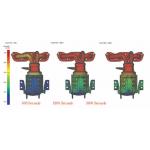 |
| Figure 3: Compared temperature distributions according to the indicated time (Model Type B). |
Such multiphysics analysis within one environment as linear and nonlinear structural analysis, transient- and frequency-based dynamic response, assembly contact, linear, nonlinear, and time-dependent thermal analysis can be run in 3G.author. The model is not changed to run any of these analyses, only the properties have to be redefined and then, for example, a thermal-stress analysis can be run.
Conclusion
Sejong’s inherent criterion—ease of use—was satisfied by an easy-to-use interface with three sections: Project Tree, Model/Results Window, and Design Control Panel. The Project Tree displays models and design cases in a hierarchical view with nested levels of features and attributes. The Model/Results Window displays separate windows for the model geometry and design case results, as well as a browser window for collaboration. The Design Control Panel captures such design constraint criteria as values and limits and ranges for parameters for on-the-fly validation and optimization.
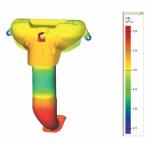
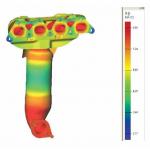
Figure 4: The results of finite element analysis (Model Type A).
“3G.author has proved to be a very useful tool for practical FEA simulation of manifold assembly models with accurate results,” said Sang Ho Kim. “In addition to meeting all our requirements, 3G.author has shown itself to be faster and easier to use than our other existing CAE programs.”
L. James Ashley is a freelance tech writer. Send your comments via about this article through by clicking here.
3G.Author
Calabasas, CA
Pro/Engineer
Needham, MA
Wulsan, South Korea
Subscribe to our FREE magazine, FREE email newsletters or both!
Latest News
About the Author
DE’s editors contribute news and new product announcements to Digital Engineering.
Press releases may be sent to them via [email protected].







